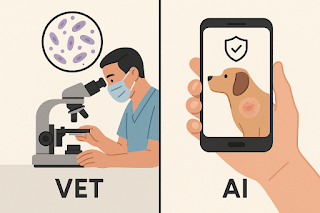Can Your Phone Really Diagnose Mange or Ringworm Accurately?
If your dog’s skin started flaking like old pastry crust today, would you trust your phone to tell you what’s wrong?
“Doc, I used an AI app on my phone and it says my cat has ringworm! Is it true? Should I start treatment?”
What Are These AI Diagnostic Tools Anyway?
In simple terms:
Examples include apps integrated with telehealth services, standalone AI diagnostic platforms or vet clinics testing AI-assisted tools to support remote triage.
Think of it as a skin-condition Shazam for your pet, identifying mange, ringworm, allergies or hot spots in seconds.
Sounds magical, right?
How Do They Work?
- Texture (crusts, flakes, oozing)
- Colour (redness, black specks, hair loss patches)
- Pattern (ring shapes in ringworm, for example)
They then match your pet’s photo to what they’ve “learned” and suggest the closest possible condition.
Why Are They Becoming Popular?
- Fast triage: Helps pet parents decide if urgent care is needed.
- Accessibility: Rural areas or after-hours support.
- Convenience: Pet parents want fast answers.
- Cost-saving: No consultation fee upfront.
- Curiosity: Who doesn’t want to test AI magic?
Plus, some apps claim 85-90% accuracy. Impressive, but let’s put that under a microscope.
The Power of AI in Animal Health Care
AI is shaking up the veterinary world like a puppy with the zoomies (those hyper running bursts every pet parent knows). From reading X-rays faster than a caffeinated intern, to monitoring heart rates with smart collars and even analysing skin photos in seconds - Artificial Intelligence is helping vets catch diseases earlier, treat pets more precisely and make top-notch care accessible to all. Sure, no app can replace your vet’s sharp eyes and diagnostic ninja skills, but AI is fast becoming our trusty sidekick - turning complex data into real-life health wins for your furry (or scaly) friends.
But… Are They Accurate for Mange or Ringworm?
Here’s the catch:
Mange (Demodectic or Sarcoptic):
Mange is caused by microscopic mites. There are two main types:
- Demodectic mange (Demodex): Usually non-itchy, patchy hair loss. Mites live in hair follicles.
- Sarcoptic mange (Scabies): Extremely itchy. Mites burrow into skin causing severe irritation.
Pets pick up mites through direct contact with infected animals or contaminated environments. Demodex is often overgrowth of naturally existing mites due to immune suppression, while Sarcoptes is contagious.
- Demodex: Weak immune system (young puppies, immunocompromised pets).
- Sarcoptes: Exposure to infected animals or bedding.
Ringworm (Dermatophytosis):
Despite the name, it’s a fungal infection, not a worm. Causes circular, scaly, hairless lesions.
Your pet comes in contact with fungal spores in soil, on infected animals, grooming tools or bedding.
Fungi thrive in warm, moist environments. Puppies, kittens and immunocompromised pets are at higher risk.
- Allergic dermatitis
- Mange
- Bacterial infections
Definitive diagnosis requires:
- Wood’s lamp examination (fluorescence in ~50% of cases)
- Fungal culture (gold standard)
- Microscopic examination
Bottom line: AI tools may suggest mange or ringworm but definitive diagnosis always requires a vet exam and lab tests.
What Can Pet Parents Do?
Here’s your toolkit:
- Use AI apps as guides, not gospel: If the app flags something concerning, book a vet appointment ASAP.
- Avoid self-treating mange or ringworm: These conditions are zoonotic (can infect humans) and misdiagnosis can worsen your pet’s health.
- Combine AI insights with professional advice: Think of your phone as a first-aid tool, your vet as the hospital.
What Can Your Vet Do?
Your vet will:
- Perform microscopic examinations or fungal cultures
- Prescribe accurate treatments - medicated dips, oral antifungals or miticidal injections
- Advise on environmental decontamination to prevent reinfection
- Supportive care for secondary bacterial infections.
Prevention
- Good hygiene: Regular grooming, disinfecting bedding and controlling fleas reduce skin problems.
- Limit exposure: Avoid letting pets roam unsupervised in high-risk environments (stray hotspots, abandoned shelters).
- Boost immunity: Provide pet proper nutrition
- Prompt vet visits: Early intervention stops the spread to other pets (or you!).
Treatment & Prognosis
- Mange: Treatable with vet-prescribed miticides; prognosis excellent if treated early.
- Ringworm: Requires antifungal treatment; prognosis good but environmental cleaning is crucial to prevent recurrence.
Zoonotic Implications
Both mange (especially sarcoptic mange) and ringworm are zoonotic:
- Ringworm: Can cause circular itchy rashes on humans.
- Sarcoptic mange: Causes itchy bumps or scabs.
Another reason not to rely solely on your phone for diagnosis!
Dr. Irtwange’s Final Bark
The other day, after that AI app call, I spent 20 minutes scraping a cranky tabby’s skin for mites, only to find ringworm instead of mange. The AI app had been close, but not close enough.
Here’s my verdict:
“Your phone can tell you where to buy pizza. It can’t tell you what’s eating your pet’s skin alive.”
Use AI apps wisely - as guides to inform your next step, not as replacements for veterinary care.
Because at the end of the day, technology works best when paired with a caring, knowledgeable human by its side.
Over to You
Share your stories in the comments! Let’s demystify these tools together.




